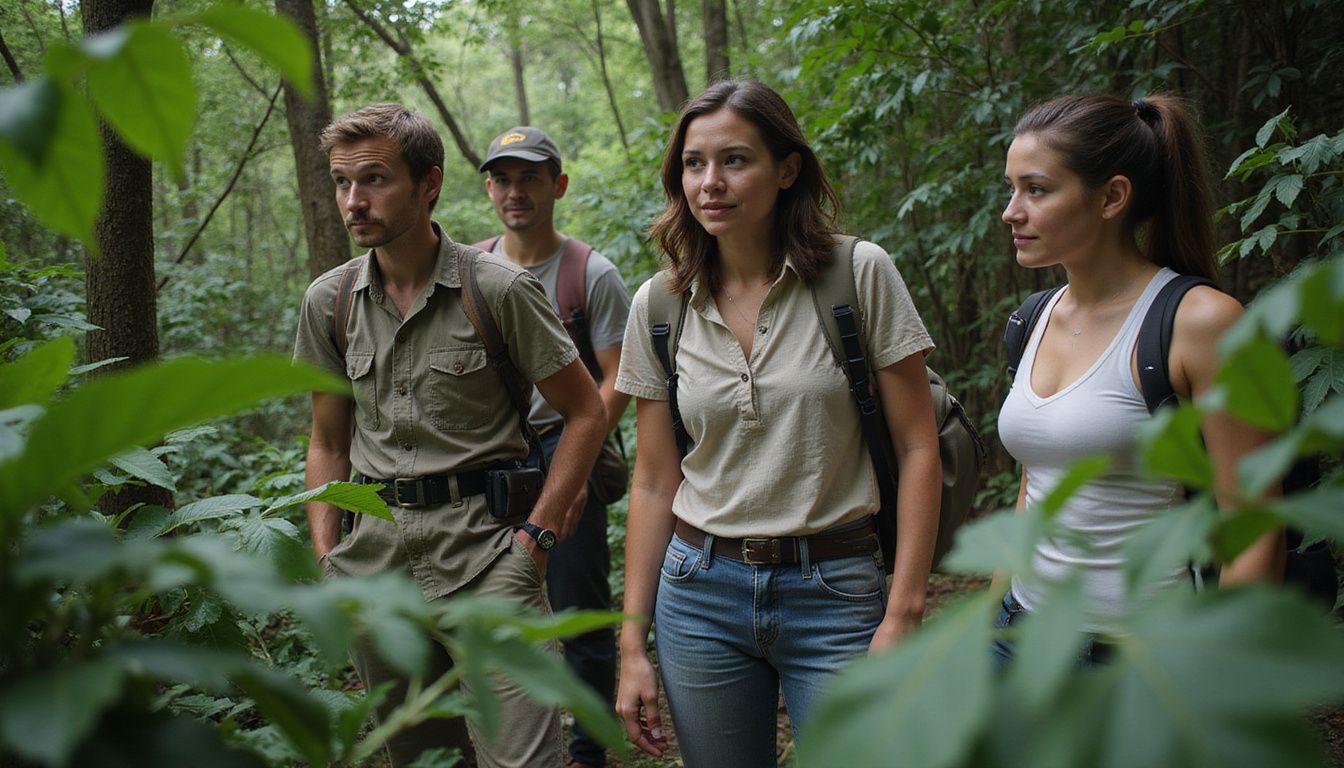Ever wonder what makes Classiaquiboituva so fascinating? This natural marvel stands out with its colorful features and smart behaviors. In this blog, you’ll learn key details about its life, habits, and impact on the environment.
Get ready to uncover something amazing!
Key Takeaways
- Classiaquiboituva thrives in tropical areas like the Amazon Basin, relying on humid environments and nutrient-rich soils.
- Its bright colors serve as both camouflage and predator warnings, aiding its survival.
- The species communicates through chemical signals and uses group strategies for safety and food finding.
- It supports biodiversity by balancing ecosystems, helping pollination, and promoting genetic diversity.
- Scientists are still studying its puzzling behaviors to better understand its role in nature and evolution.
Characteristics of Classiaquiboituva

Classiaquiboituva displays striking physical features and fascinating behaviors that set it apart in nature. Its movements, interactions, and adaptations reveal much about its role within ecological systems.
Physical Attributes
Bright colors cover its body, helping it blend into the vibrant plant life in riparian zones. These shades also act like a warning to possible predators, showing it might not be easy prey.
It measures between 10 and 15 centimeters long. Its specialized appendages improve grip on wet surfaces in the Amazon Basin’s rainfall-soaked habitats. Textured surfaces make interactions with organic matter smoother, aiding foraging efforts effectively.
Behavioral Traits
Classiaquiboituva shows fascinating behaviors. It uses chemical signals to “talk” with others in its group, ensuring clear communication. Selective feeding habits help it save energy by focusing only on the most nutritious resources available.
These traits highlight a smart survival strategy.
Courtship involves bold visual displays. Bright colors or specific movements act as signals during mating season, catching potential mates’ attention. Cooperation is also key to survival.
Visual cues often guide group efforts, like finding food or avoiding predators, creating balance within their ecological community.
Nature’s best lessons come from teamwork and clever strategies.
Habitat and Distribution
Classiaquiboituva thrives in areas with rich biodiversity and balanced ecosystems. Its presence often signals the health of coastal regions and nearby environments.
Preferred Environments
This phenomenon thrives in tropical and subtropical areas with stable humidity. It favors rainforests, riparian zones, and rocky outcrops. Temperatures between 68°F to 86°F create the perfect setting for its growth.
Partial shade mixed with sunlight helps sustain it.
Nutrient-rich soils are a must for its survival. It often appears near freshwater sources or along coastal regions where nutrient cycling occurs naturally. These habitats support biodiversity and promote ecological balance.
Its distribution leads directly into understanding the “Geographic Range.
Geographic Range
Classiaquiboituva thrives in Central and South America. It appears most commonly in the Amazon Basin and along Brazil’s coasts. Colombia, Ecuador, and Venezuela also report its presence.
These creatures adapt to elevations ranging from sea level up to 1,500 meters.
From dense forests to coastal zones, Classiaquiboituva proves its adaptability.
Its habitats span tropical rainforests like the Amazon to humid lowlands by rivers. Its range highlights biodiversity hotspots crucial for environmental science research and conservation efforts.
Ecological Significance
Classiaquiboituva plays a big part in keeping ecosystems balanced. Its behavior affects pollination, predator-prey systems, and even soil microorganisms.
Role in Biodiversity
It helps keep ecosystems healthy by balancing predator and prey populations. Acting as both, it manages species numbers, avoiding overpopulation or scarcity.
Its presence supports biodiversity and boosts genetic diversity. It even provides tiny habitats for microorganisms, aiding in nutrient cycling.
Interaction with Other Species
Classiaquiboituva plays a vital role in plant reproduction. Its behavior assists pollinators, like bees, butterflies, and certain birds. This connection helps maintain ecosystem health and biodiversity by encouraging the propagation of local flora.
Through symbiotic relationships, it supports other species’ survival. Pollinators feed on nectar while spreading pollen across plants. Such interactions strengthen cultural landscapes like the Amazon rainforest, ensuring environmental conservation efforts benefit multiple organisms at once.
Cultural and Community Impact
Classiaquiboituva weaves itself into local stories and art, sparking creativity. Its presence shapes traditions, leaving a deep mark on community life.
Connection to Local Traditions
Locals often tie Classiaquiboituva to their cultural heritage. Its presence inspires artistic expressions, such as folk songs and dances. Many communities view it as a symbol of nature’s balance, blending old ways with fresh innovations.
In some areas, this species connects deeply with spiritual rituals. Elders share stories of its role in seasonal changes or courtship displays among rare wildlife. These traditions keep the bond between people and ecology strong, fostering respect for biodiversity over generations.
Influence on Regional Practices
Research on Classiaquiboituva shapes local conservation habits. Its specific environmental needs push communities to adjust farming and land use. These changes protect the species while promoting biodiversity.
Local traditions now often include rituals or stories tied to its presence, strengthening cultural ties.
Efforts to understand its ecological roles inspire regional preservation policies. Communities engage in planting native plants or limiting harmful practices like deforestation. Conservation programs also spark interest in educational workshops, boosting awareness among younger generations.
Key Adaptations of Classiaquiboituva
Classiaquiboituva thrives by adjusting to harsh conditions with ease, showing nature’s knack for problem-solving. Its clever changes help it face challenges head-on, setting an example of survival brilliance.
Survival Strategies
Survival in nature is a constant challenge. This phenomenon shows clever strategies to thrive in its environment.
- It adapts to seasonal changes quickly, adjusting its reproductive cycles based on weather patterns. This ensures survival by aligning births with food availability.
- Its physical features help it blend into surroundings, reducing attention from predators. Camouflage works as an essential shield in diverse habitats.
- It stores energy efficiently during scarce months, using fat reserves for sustenance. This helps it endure harsh seasons without consistent resources.
- Its behavioral traits include forming groups for protection. Strength in numbers keeps it safer from threats.
- It moves to areas with better conditions when the environment becomes unsuitable. Migration improves access to water, food, and shelter.
- Interaction with other species strengthens its ecosystem role. By working within biodiversity networks, survival odds improve.
- It builds resilience toward environmental shifts like temperature or habitat destruction over time through evolutionary history. Adaptation allows continued existence in changing scenarios!
Environmental Resilience
Classiaquiboituva shows impressive resilience in nature. This ability ensures its survival in challenging habitats.
- It thrives in tropical and subtropical areas, adjusting well to warm climates. Humid environments with nutrient-rich soils are ideal for its growth.
- The species has vibrant colors that help it blend into surroundings or scare predators. These visual features play a big role in protection.
- Special appendages improve its adaptability. They allow better movement or interaction within their habitat.
- It contributes to biodiversity by keeping ecosystems balanced. Its presence supports plant reproduction through nutrient cycling.
- Symbiotic relationships with other species are essential for survival and ecosystem health. These partnerships boost mutual benefits in the environment.
- The ability to adapt quickly protects it from environmental changes like droughts or habitat loss, showcasing true strength against challenges.
- Its role in ecosystems reflects how nature carefully connects all living things.
Unanswered Mysteries and Future Research
Scientists still wonder why Classiaquiboituva behaves differently in similar habitats. There’s hope that new research will unravel these hidden puzzles.
Unknown Behaviors
Classiaquiboituva shows actions that puzzle researchers. Some movements seem random, while others may hide clear intentions. It might use patterns that help it adapt, yet these remain mostly hidden from science.
Experts push for more data to uncover its secrets. Anthropology or fintech-related advancements could even offer surprising connections to its behaviors! Its habits will likely shape future discoveries about biodiversity and survival strategies.
Potential Discoveries
Its complex structure might open doors to new ecological connections. Researchers could uncover fresh links in biodiversity or better understand its role in maintaining balance within ecosystems.
The biological classification of Classiaquiboituva may also offer clues about past environments and its evolutionary path.
Exploration of untouched habitats may reveal hidden behaviors or adaptations not yet documented. These findings could lead to groundbreaking advances in knowledge, aiding scientific studies across multiple fields.
Interdisciplinary approaches promise exciting breakthroughs that expand our understanding of nature’s endless surprises.
Conclusion
Classiaquiboituva sparks curiosity and wonder. Its vibrant traits, clever behaviors, and key role in nature make it stand out. From its selective diet to stunning courtship signals, every detail invites more questions.
Nature hides secrets within this phenomenon, urging future discoveries. The journey to understanding it has only just begun!
FAQs
1. What is Classiaquiboituva?
Classiaquiboituva is a natural phenomenon that scientists study through taxonomy to better understand its role in the environment.
2. How do researchers gather information about Classiaquiboituva?
Researchers use tools like browsers and financial technology (fintech) platforms to collect, organize, and analyze data efficiently.
3. Can financial technology help explore nature’s phenomena like Classiaquiboituva?
Yes, fintech helps fund studies, manage resources, and process large amounts of information for research purposes related to natural events like this one.
4. Why does taxonomy matter when studying Classiaquiboituva?
Taxonomy provides a system to classify and organize details about this phenomenon, making it easier for experts to share findings globally.





